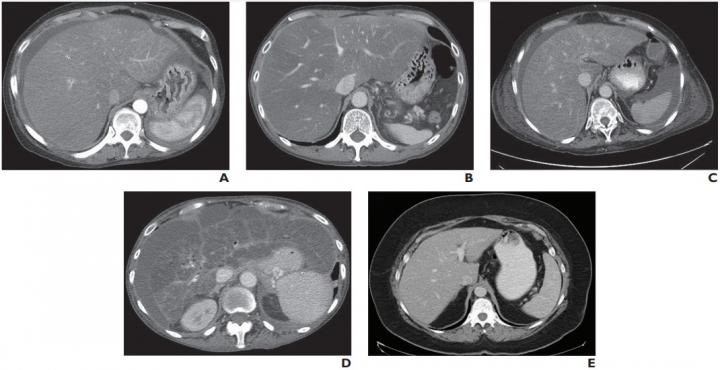Multiparametric CT findings can distinguish patients with high-risk NAFLD (advanced fibrosis or cirrhosis); however, the presence of nonalcoholic steatohepatitis (NASH) remains elusive for the modality

Credit: American Roentgen Ray Society (ARRS), American Journal of Roentgenology (AJR)
Leesburg, VA, January 22, 2021–According to ARRS’ American Journal of Roentgenology (AJR), Fibrosis-4 (FIB-4) and multiple CT findings can identify patients with high-risk nonalcoholic fatty liver disease (NAFLD)–advanced fibrosis or cirrhosis, that is–though the presence of nonalcoholic steatohepatitis (NASH) remains elusive on CT.
“Subjective assessment of multiple morphologic and separately quantified parameters by trained readers and a simple quantitative three-parameter model combining two CT features, liver surface nodularity (LSN) and liver segmental volume ratio (LSVR), and a clinical score (FIB-4) showed good association with presence of advanced fibrosis,” wrote first author Meghan G. Lubner from the department of radiology at the University of Wisconsin School of Medicine and Public Health.
Based on a presentation at the ARRS 2019 Annual Meeting, Honolulu, HI, patients with biopsy-proven NAFLD who underwent CT within 1 year of biopsy were included. An experienced gastrointestinal pathologist performed a histopathologic review to determine steatosis, inflammation, and fibrosis. The presence of any lobular inflammation and hepatocyte ballooning was categorized as nonalcoholic steatohepatitis (NASH), while patients with NAFLD and advanced fibrosis (stage F3 or higher) were categorized as having high-risk NAFLD. Two readers subjectively assessed the presence of NASH and fibrosis.
The final cohort consisted of 186 patients (mean age, 49 years; 112 women and 74 men), of whom 87 (47%) had NASH and 112 (60%) had moderate to severe steatosis. A total of 51 patients were classified as fibrosis stage F0, 42 as F1, 23 as F2, 37 as F3, and 33 as F4. Additionally, 70 (38%) had advanced fibrosis (stage F3 or F4) and were considered to have high-risk NAFLD. FIB-4 score showed correlation with fibrosis, and of the individual CT parameters, LSVR and splenic volume had the best performance. Meanwhile, subjective reader assessment performed best among all parameters. FIB-4 and subjective scores were complementary, and for NASH assessment, FIB-4 performed best.
Noting the well-established utility of CT in identifying hepatic steatosis, the authors of this AJR article concluded that CT can also be “a highly accessible, frequently used method for assessment of patients with NAFLD and identification of those with high-risk NAFLD (advanced fibrosis or cirrhosis) who are potentially most in need of intervention.”
###
Press passes available for the ARRS 2021 All-Virtual Annual Meeting: https:/
Founded in 1900, the American Roentgen Ray Society (ARRS) is the first and oldest radiological society in North America, dedicated to the advancement of medicine through the profession of radiology and its allied sciences. An international forum for progress in medical imaging since the discovery of the x-ray, ARRS maintains its mission of improving health through a community committed to advancing knowledge and skills with an annual scientific meeting, monthly publication of the peer-reviewed American Journal of Roentgenology (AJR), quarterly issues of InPractice magazine, AJR Live Webinars and Podcasts, topical symposia, print and online educational materials, as well as awarding scholarships via The Roentgen Fund®.
Media Contact
Logan K. Young
[email protected]
Related Journal Article
http://dx.



